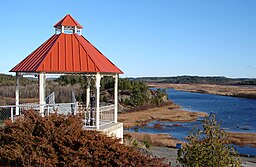Spanish River (Ontario)
| Spanish | |
| River | |
|
Mouth of the Spanish River at the Town of Spanish
|
|
| Country | Canada |
|---|---|
| Province | Ontario |
| Source | Biscotasi Lake |
| - location | Unorganized Sudbury, Sudbury District |
| - coordinates | 47°17′40″N 82°00′00″W / 47.29444°N 82.00000°W |
| Secondary source | Alligator Lake |
| - location | Unorganized Sudbury, Sudbury District |
| - coordinates | 47°25′35″N 81°51′54″W / 47.42639°N 81.86500°W |
| Source confluence | |
| - location | Unorganized Sudbury |
| - coordinates | 47°02′15″N 81°51′12″W / 47.03750°N 81.85333°W |
| Mouth | North Channel (Lake Huron) |
| - location | Spanish, Algoma District |
| - coordinates | 46°11′04″N 82°18′41″W / 46.18444°N 82.31139°WCoordinates: 46°11′04″N 82°18′41″W / 46.18444°N 82.31139°W |
| Length | 338 km (210 mi) |
| Basin | 14,000 km2 (5,000 sq mi) |
| Discharge | |
| - average | 150 m3/s (5,300 cu ft/s) |
The Spanish River is a river in Algoma District, Sudbury District and Greater Sudbury in Northwestern Ontario, Canada. It flows 338 kilometres (210 mi) in a southerly direction from its headwaters at Spanish Lake (west branch) and Duke Lake (east branch) to its mouth at the North Channel on Georgian Bay, Lake Huron just outside the community of Spanish.
The river is located almost entirely within the Sudbury District, except for brief passages into the city of Greater Sudbury near the communities of High Falls and Turbine and the river mouth in Algoma District.
Tributaries include Pogamasing Creek, Mogo Creek, Agnes River, the Aux Sables River, the Vermilion River and the Wakonassin River.
The river's name and the name of the nearby towns of Espanola and Spanish are said to be due to French explorers and Jesuit priests encountering Ojibwe peoples speaking Spanish in the area, apparently as a result of a Spanish woman having been taking captive during an expedition far to the south.
The Lower Spanish River Forest houses the world's oldest red pine and white pine forests, and much of that is under provincial protection, in form of provincial parks and reclamation acts.
This river has been used as a transportation corridor for thousands of years, first by First Nations and later in the 19th century by fur traders. During the late 19th and mid 20th centuries, it was used to transport timber from logging camps in the upper Sudbury District to Georgian Bay, where they were towed by tugs to sawmills on the Great Lakes. Until the mid-1960s pulp wood, mainly jack pine, was driven down the river to the paper mill at Espanola. A diesel tug towed large rafts of logs the length of Agnew Lake to big Eddy dam where they were sluiced down a flume by crews with hand held pike poles. Secondary flumes took them past the High Falls and Nairn Falls power plants and on to Espanola. The sap and bark from the pulp logs was a major pollution source in the lower river.
...
Wikipedia


